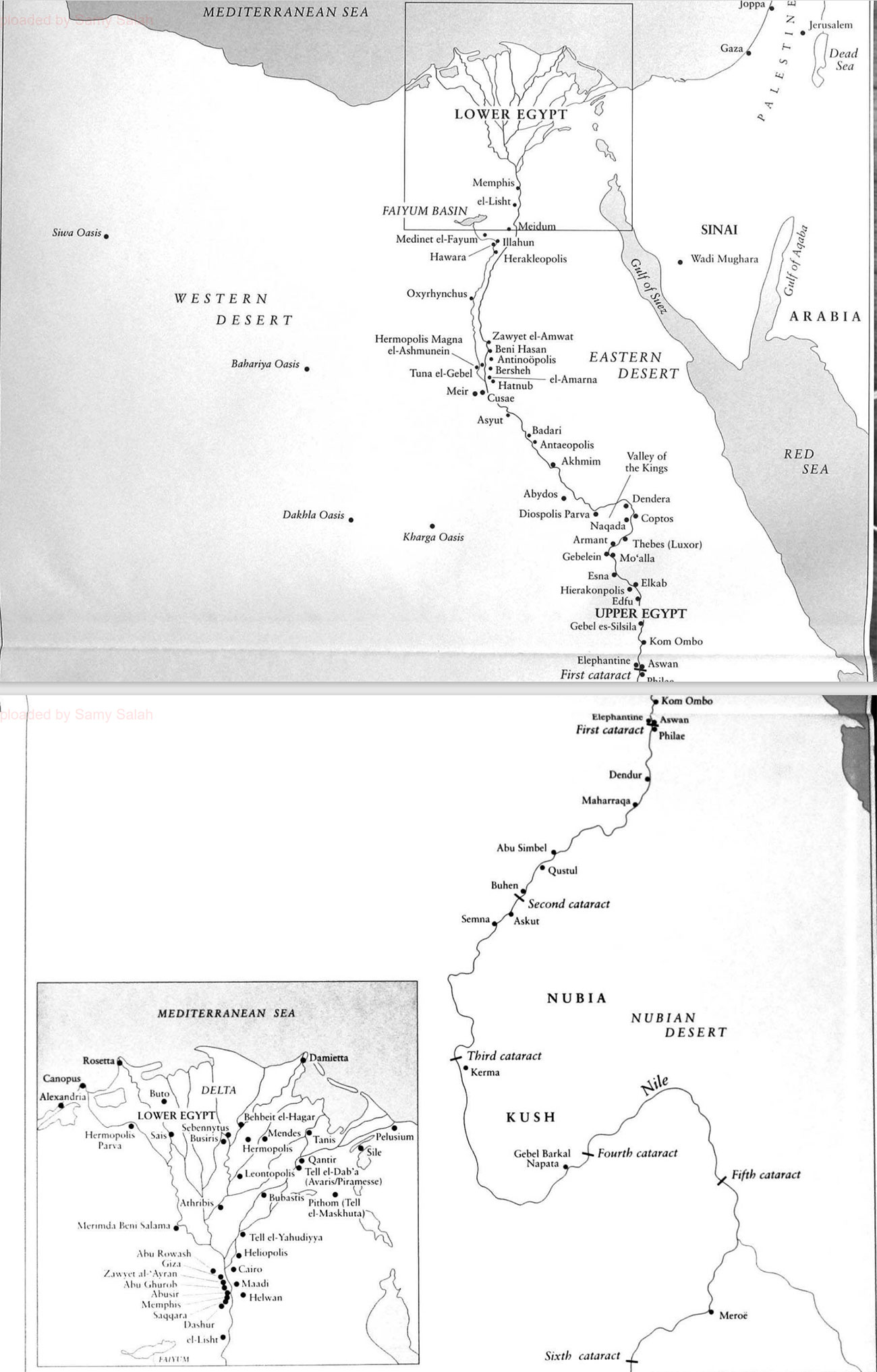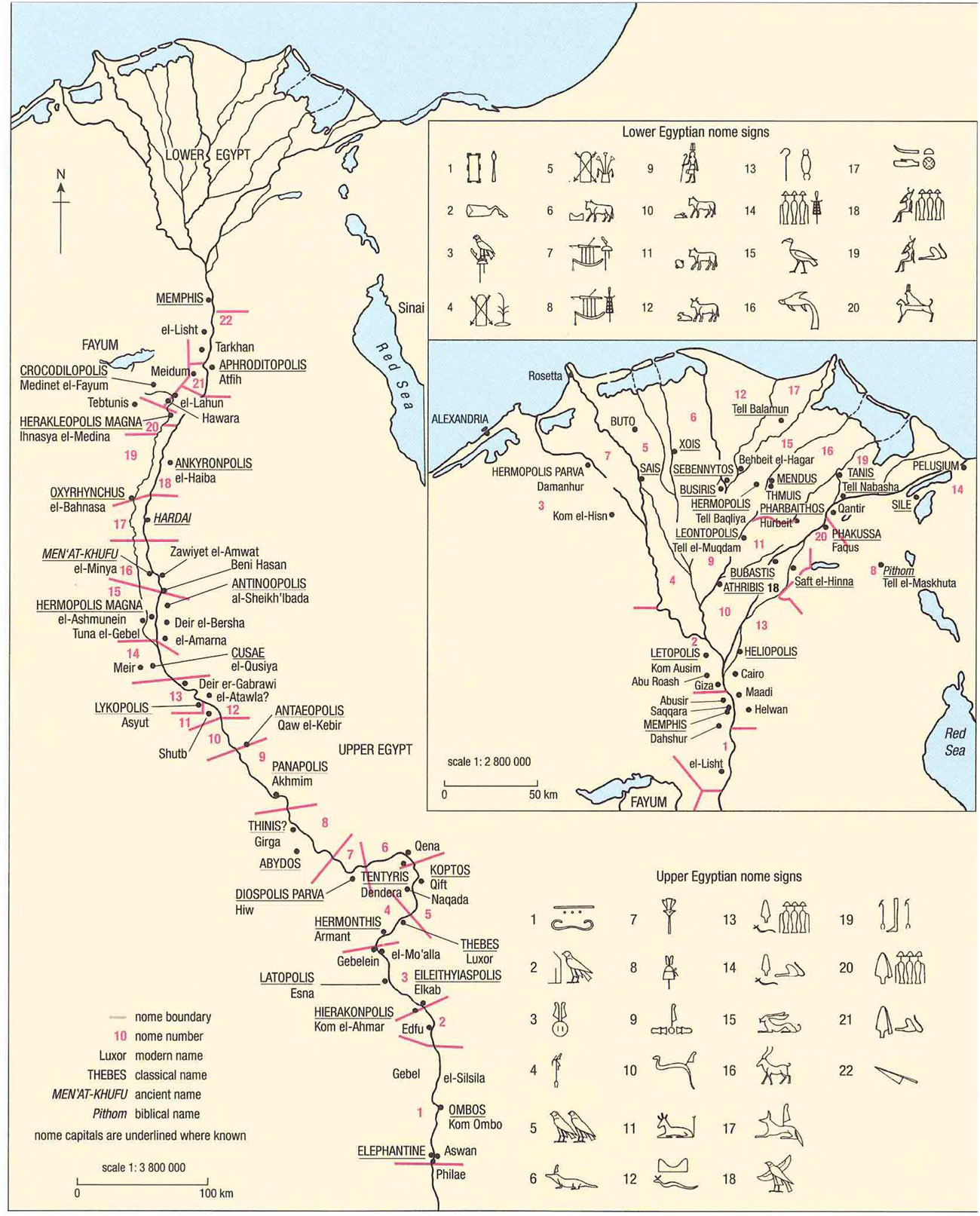READING HALL "THE DOORS OF WISDOM" |
 |
HISTORY OF ANCIENT EGYPT |
 |
CHAPTER III.
THE LEGENDARY PERIOD.
The fact that the ancient Egyptians of the historical
period attempted to formulate their hazy ideas concerning the predynastic
period of their history and its duration is made known to us by certain of the
versions of the King List of Manetho, which have been preserved by George the
Syncellus. The statements which refer to this period that are found in them, as
well as the numbers of years which the gods, demigods, kings, ghosts, etc.,
are alleged to have reigned, prove that those who drew up the materials from
which Manetho compiled his King List had no correct knowledge of the duration
of the Predynastic Period in Egypt or even of the early Dynastic Period, and it
is now quite clear that even in the time of the XIXth Dynasty its history had long since degenerated into legend and a confused mass
of hopelessly mixed tradition. According to George the Syncellus the Egyptians
possessed a “certain tablet called the “Old Chronicle, containing thirty
dynasties in 113 descents, during the long period of 36,525 years. The first
series of princes was that of the Auritae, the second
was that of the Mestraeans, and the third of
Egyptians.” The reign of the gods was as follows:—
HEPHAISTOS , to whom “ is assigned no time, as he “is
apparent both by day and by night.”
HELIOS , the son of Hephaistos, reigned 30,000 years.
KRONOS , and the other twelve gods, reigned 3984 years.
Demi-gods, eight in number, reigned 217 years.
The 30 dynasties of kings reigned 2324 years, and thus
we get a grand total of 36,525 years for the duration of the Predynastic and
Dynastic Periods in Egypt. The Syncellus goes on to say that the period of
36,525 years equals 25 times 1461 years, and that it “relates to the fabled
periodical revolution of the zodiac among the Egyptians and Greeks, that is,
its revolution from a particular point to the same again, which point is the
first minute of the first degree of that equinoctial sign which they call the
Ram, as itis explained in the Genesis of Hermes and in the Cyrannian books.”
According to Eusebius1 the duration of the Predynastic
and Dynastic Periods was as follows :—
I. Gods 13,900 years.
II. Demi-gods
1. Demi-gods 1,255
2. Other kings 1,817
3. Thirty Memphite kings 1,790
4. Ten kings of This 350
III. Manes 5,813
Total 24,925 years.
According to Manetho and Panodorus the Divine Dynasties were as follows :—
I. Gods (Panodorus) (Manetho)
Years. Years.
1. Hephaistos 727’3/4 9,000
2. Helios 80’1/6 992
3. Agathodaemon 56’1/2 700
4. Kronos 40’1/2 501
5. Osiris and Isis 35 433
6. Typhon 29 359
-------- -----------
969 11,985
II. Demi-gods (Panodorus) (Manetho)
Years. Years.
7. Horus 25 100
8. Ares 23 92
9. Anubis 17 68
10. Herakles 15 60
11. Apollo 25 100
12. Ammon 30 120
13. Tithoes 27 108
14. Sosus 32 128
15. Zeus 20 80
(Wanting) ½ (wanting) 2
------- --------
214’1/2 858
Thus according to Manetho the reigns of the Gods and
Demi-gods lasted about 12,843 years, and according to Panodorus about 11,834 years. The beings who are thus described as “Gods” and “Demi-gods”
may or may not have been primeval chiefs or heads of tribes, but there can be
little doubt that by the words demigods we are to understand an allusion to the dead
chiefs who flourished during the period which immediately preceded that of the
1st Dynasty. The demigods are in fact neither more nor less than the
well-known “ Shemsu Heru,” or “Followers of Horus,” a class of beings who
are mentioned frequently in Egyptian literature from the earliest times, and
who seem to have introduced a higher grade of civilization into Egypt; possibly
they came, as has been said above, from the East by way of the upper part of
the Nile Valley. Of such chiefs or kings traces have been found, and a number
of tombs which have been declared to be, and probably are, their sepulchres have been excavated during the years 1900 and
1901 at Abydos. With these we may not now class that of KHENT, who was
certainly a successor of Mena, or Menes. The sign which expressed his name was,
at a very early period, identified with the epithet applied to the god Osiris
as “chief” of Amenti, and in the XIXth Dynasty, and probably earlier, we find that the tomb of the king KHENT was
regarded as that of the god. Possibly the earliest king of the group was TE or
DE, the symbol of his name being the hand. With this king must also be
mentioned two monarchs who reigned over Upper Egypt who were called Re, or Ro, and
Ka. From the evidence now forthcoming we are justified in saying that long
before the unification of the rule of the Nile Valley under Mena, Upper Egypt,
i.e., the country from the Fayyum on the north to
about Silsila on the south, and Lower Egypt, i.e., the Delta and a small
portion of Middle Egypt, existed as two entirely distinct and independent
kingdoms. The kingdom of Lower Egypt was probably the older, that is to say, it
seems to have been inhabited by the descendants of the aboriginal north-east
African race who were conquered by the Shemsu Heru, or the “Followers of Horus”,
i.e., the founders of the historical kingdom which had its beginning in Upper
Egypt. This fact is proved by the use of the word SUTEN in the Egyptian
language of the historical period; originally the SUTEN was the “king of Upper
Egypt,” and the king of Lower Egypt was called NET or BAt,
a word which has been conjectured to be of Libyan origin. It is worthy of note
that in the group which means “King of the South and North,” the sign for “king
of the South” precedes that of “king of the North.” Now gradually the word
SUTEN gained the meaning of king, par excellence, a signification which the
word NET or BAT never acquired. The fact that the Egyptians themselves always
regarded their country as composed of two kingdoms, i.e., Upper and Lower
Egypt, is proved by the two crowns which are usually united on the heads of
their sovereigns. The crown of Upper Egypt was represented by the sign and was
called HETCHET h, because of its “white” colour, and
the crown of Lower Egypt was called TESHERT , because of its “red” colour; the united crowns were represented by a sign which
has been commonly but erroneously read “Pschent,” the correct reading being, of
course, “Sekhet.” Egyptian kings of the dynastic
period were never tired of calling themselves “Lord of the two lands,” a title
which we now know must refer to the two kingdoms of the South and North, and
not to the ATEBUI, or east and west banks of the Nile. Moreover, in the
earliest dynastic times the king of all Egypt was already distinguished by the
title i.e., “lord of the city of the goddess Nekhebet,”
and “ lord of the city of the goddess Uatchet,” i.e.,
“lord of Eileithyiapolis and Buto,” which were held
to be the representative cities of the South and the North. The idea of the union
of the South and the North was symbolically expressed by the hieroglyphic which
was intended to represent the tying together of the papyrus and lotus, plants
which typified the South and the North respectively; the sign is read “ SAM TAUI,”
i.e., “union of the two lands,” and is found engraved on the thrones of seated
statues of kings. The first instance of its use occurs on a vase of King Besh,
i.e., Kha-sekhem (Kha-sekhemui),
the Betchau of the King Lists.
We have already stated that of the independent kings
of Upper Egypt the names of three are known, i.e., Te or De, and Re, and Ka; of certain of the early independent kings of Lower Egypt
we have a most interesting record on a monument which is preserved in the
Museum of Palermo in Sicily, and of which an interesting account has been
written by Signor A. Pellegrini. The inscriptions upon this monument or stele
show that when complete it probably contained a list of the festivals
celebrated in honour of various gods by kings who
reigned before the end of the Vth Dynasty; it is important to remember in
considering what follows that this monument itself dates from the Vth Dynasty,
and that it is not removed from the predynastic period by an interval of time
greater than 500 years. In the uppermost register occur the following names of
predynastic kings of Lower Egypt, and each name is followed by the hieroglyphic
for a seated king who is wearing the crown of Lower Egypt only on his head.
1.
SEKA 2.
TESAU 3. TAU 4. THESH5. NEHEB 6. UATCH NAR 7.
MEKHA
When and exactly where these kings reigned cannot be
said, but it seems certain that they were independent kings of Lower Egypt who
reigned before the time of Mena, or Menes.
|
by
By

